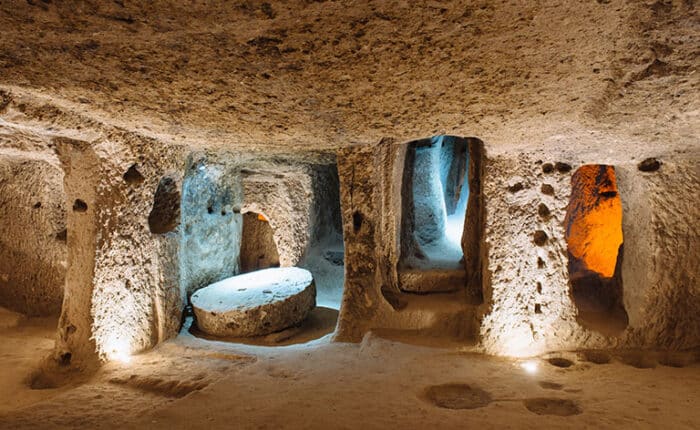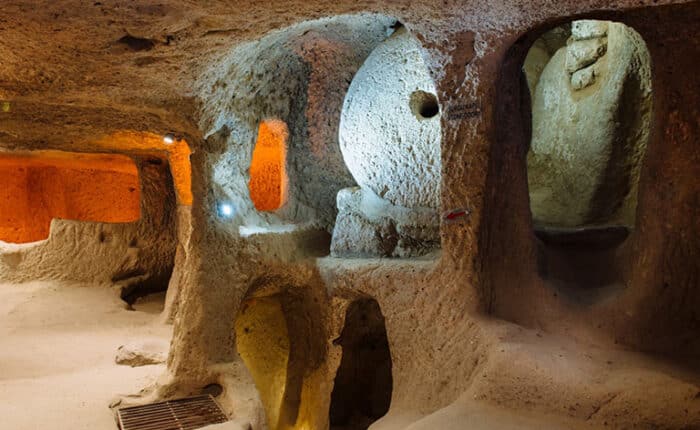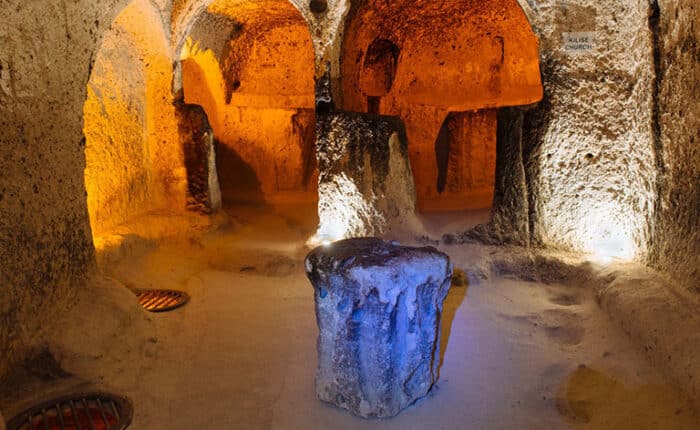Like with other underground cities, Kaymakli’s actual construction period is unknown; some attribute its construction to the Hittites while others to the Phrygians. It was established under the citadel or sanctuary of Kaymakli (Greek: Enegup) and, for centuries, has served as a refuge for Cappadocian residents.
In the 4th century, Christians in the Roman empire were facing religious persecution from the Romans. During their flight, the Christians found a haven in the region of Cappadocia. Here they built cave houses, churches, and tunnels in the soft volcanic rock of the area. They also expanded the existing underground city at Kaymakli to include churches, graveyards, stables, and schools.
The Christians used the city until the 14th century, and when the region fell to the Seljuk Turks, residents once again escaped to the safety of their underground cities. There are even records that the town was used until the early 20th century by the Cappadocian Greeks. It was finally abandoned around the 1940s and opened to the public in 1964.
Out of the eight levels that the city is thought to have, only four have been uncovered. Nonetheless, they are still enough to give you a solid idea of how life in the underground city went on.
The first level is home to a stable. The stable is relatively small in size, and thus, it is speculated that there could be other stables in the lower levels yet to be opened. There is a millstone door to the left of the stable that opens up to a church. There are also rooms on the right. These rooms are believed to have served as living spaces for wealthy families.
This floor is home to a church with a nave and two apses. There is a baptismal font in front of the apses and seating platforms on the sides. The church also has names next to the church, which are the same names in the graveyard contained on the same floor. There are also a few living spaces in the area.
Of all the uncovered levels, the third floor is arguably the most important one. It served as the storage section for food and had places for wine and oil presses and communal kitchens. There is also an intriguing block of andesite with relief textures.
The fourth level is also home to a large number of storage rooms. In this section, there is a private kitchen, flour furnaces, and earthenware areas. This floor is an indication of a certain level of economic stability in the region.
Underground cities had to overcome any challenges, but the greatest one was ventilation. Therefore, these towns’ architects had to develop ingenious ways to ensure inhabitants had a constant clean air supply. They constructed ventilation shafts that ran all the way to the lowest levels. Today, these shafts are some of the most exciting features of any underground city, and Kaymakli is no different.



Getting to Kaymakli underground city is an easy 30-minute drive from Goreme town. It is also quite scenic, so don’t shy away from taking a slow drive while taking in the stunning surroundings outside your window.
Exploring the massive underground town makes for the most exciting experience. The city gives you an exclusive sneak peek into the lives of Cappadocian Christians in the dark ages. Walking through the many tunnels and chambers in Kaymakli, you get to see the different features that made life in this underground city as usual as the life above the ground.
If you have been to Derinkuyu, you will notice that the tunnels here are narrower. Therefore, exploring the tunnels can be quite challenging for tourists as it was for invaders hundreds of years ago. These narrow tunnels forced invaders to crouch and form a single file, making it easier for citizens to defend their city.
Other impressive features of the city are the massive round stone boulder sit in doorways leading to tunnels. Several men would roll the boulder across the doorway during an attack, lock the invaders outside and the city inhabitants inside.
Opening Hours
From April 1st to October 1st, the city is open between 8 am and 7 pm.
From October 1st to April 1st, it is open between 8 am and 5 pm.
There are lots of magnificent attractions near the underground city of Kaymakli. These include the Derinkuyu Underground City, Pasabag Valley, Goreme Open Air Museum, and Zelve Open Air Museum.